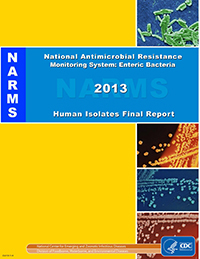Some types of Salmonella and other bacteria are increasing their resistance to antibiotics, according to a new report from the National Antimicrobial Resistance Monitoring System (NARMS) which tracks antibiotic resistance in humans, farm animals and deli meat. Each year, about 440,000 Americans develop antibiotic-resistant infections from foodborne germs.

CDC image
Created in 1996, NARMS is an interagency collaboration of the Centers for Disease Control and Prevention (CDC), the U.S. Food and Drug Administration (FDA) and the U.S. Department of Agriculture (USDA).
It tracks antibiotic resistance in six pathogens: non-typhoidal Salmonella, typhoidal Salmonella, Shigella, Campylobacter, E. coli O157, and Vibrio. The new report, based on information from 5,000 isolates gathered in 2013, compares results to data from 2004-2008 and 2008-2012.
For Salmonella overall, multidrug resistance was 9.8 percent in 2013 compared with 9.2 in 2008 and 11.2 in 2004. But some Salmonella types showed cause for concern. The Salmonella serotype I4,[5],12:i:- , for example, was drug-resistant in 46 percent of cases in 2013, more than double the 18 percent rate in 2011.
Some types of other bacteria showed strong resistance to one drug. Ciprofloxacin resistance in Campylobacter jejuni has remained over 20 percent in all three periods: 22.3 percent in 2013, 23.4 in 2008 and 21.6 in 2004.
Nalidixic acid resistance in Salmonella Typhi, the bacteria that causes typhoid fever, was 67.4 percent in 2013 compared with 65.5 percent in 2008 and 53 percent in 2004. While Nalidixic acid resistance in Shigella was 5.2 percent in 2013, up from 3.8 percent in 2008 and 2 percent in 2004.




